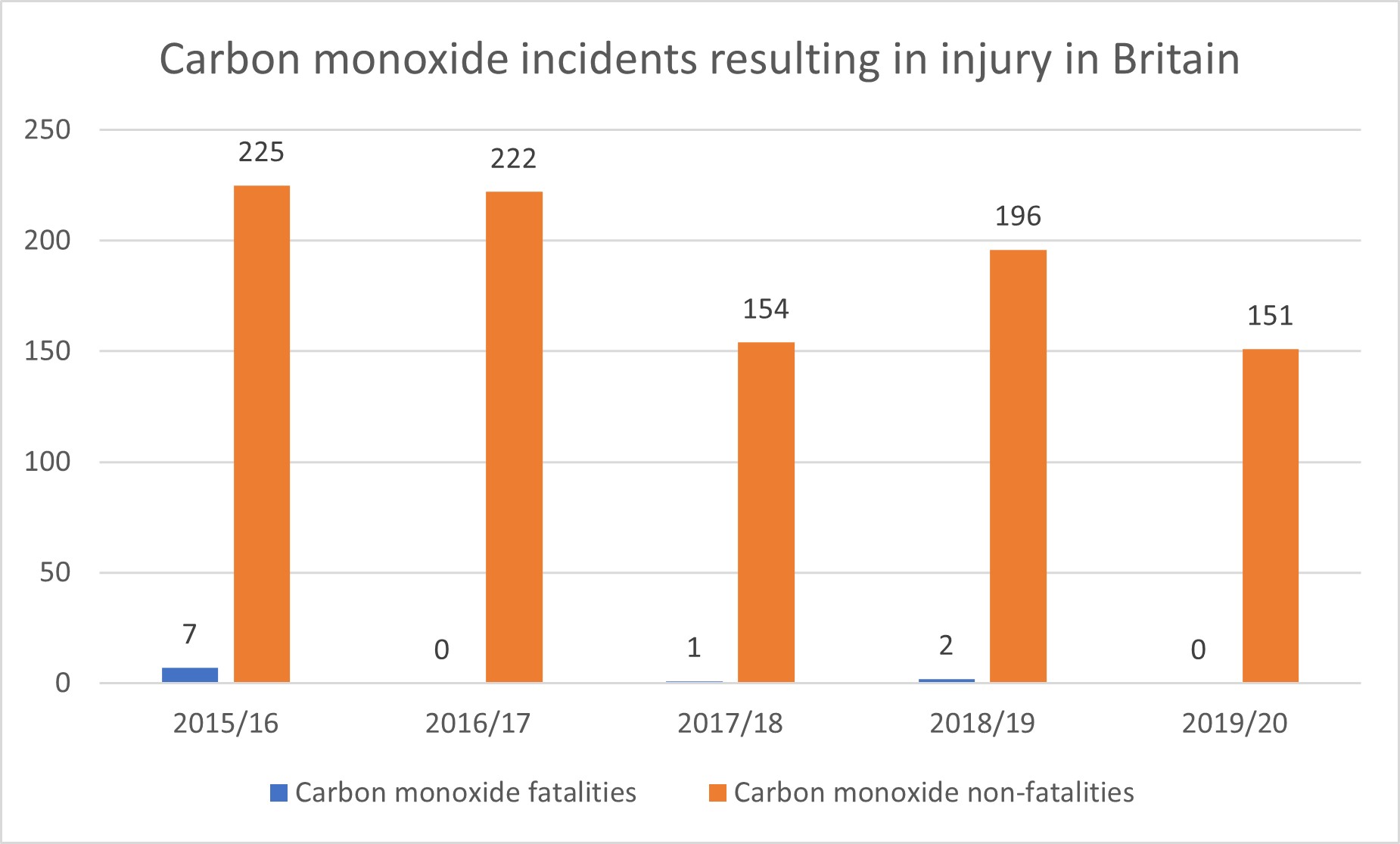How To Claim For Carbon Monoxide Poisoning At Work
In this guide, we will examine carbon monoxide poisoning at work. Carbon monoxide poisoning can be potentially lethal. If you have been made ill by exposure at work caused by your employer breaching their duty of care, you could be owed personal injury compensation.

Carbon monoxide poisoning at work guide
Our aim is to make a carbon monoxide poisoning at work compensation claim more straightforward with the right advice. At Legal Expert, our advisors are on hand to answer your questions right now. You can start straight away by:
- Calling our team on 0800 073 8804
- Emailing us at Legal Expert
- Using the ‘live support’ portal to the bottom right of this screen for instant help
Select A Section
- A Guide To Claiming For Carbon Monoxide Poisoning At Work
- What Is Carbon Monoxide Poisoning At Work?
- Carbon Monoxide Poisoning Symptoms
- What Are The Effects Of Carbon Monoxide Poisoning At Work?
- Treating And Recovering From Carbon Monoxide Poisoning
- Causes Of Exposure To Carbon Monoxide At Work
- Steps Employers Could Take To Prevent Exposure To Carbon Monoxide
- What Should You Do If You Suspect A Leak?
- What Professions Are More At Risk Of Carbon Monoxide Exposure?
- Carbon Monoxide Exposure Statistics
- Calculate Compensation For Carbon Monoxide Poisoning At Work
- Additional Damages
- No Win No Fee Compensation Claims For Carbon Monoxide Poisoning At Work
- Start Your Claim
- Essential References
- Carbon Monoxide Exposure FAQs
A Guide To Claiming For Carbon Monoxide Poisoning At Work
Carbon monoxide poisoning at work can be caused by negligence on the part of your employer and can make you very ill. If you have evidence to prove that you were exposed to carbon monoxide at work because your employer failed to safeguard you, you could claim. This guide will look at the steps you can take if you’re injured at work.
In this article, we examine the laws that are in place to protect employees in the workplace as possible. We look at the responsibilities of employers to fulfil this legal duty of care and some ways in which it could be breached. By looking at the risks to your health and potential impact on your health and finances, we explain how two types of damages can be calculated to properly address the harm caused.
To conclude this guide, we explain the benefits of starting a case like this with a personal injury solicitor on a No Win No Fee basis. Whilst you are not legally required to have a lawyer and can manage a claim independently, our aim is to help make seeking compensation as efficient and straightforward as possible.
What Is Carbon Monoxide Poisoning At Work?
Carbon monoxide (CO) poisoning happens when carbon monoxide accidentally leaks from a gas appliance in the workplace or home. Carbon monoxide is produced when fuel like coal, wood, gas or oil doesn’t burn fully.
The Control of Substances Hazardous to Health Regulations 2002 is the legislation that outlines what employers need to do to manage the risk of carbon monoxide in the workplace. If carbon monoxide poisoning is a potential danger to employees, employers are legally required to ensure that all steps are being taken to limit risk as much as possible.
You can get in touch with our team today for more information about claiming for harm caused by carbon monoxide poisoning. Otherwise, read on to find out more about how this could affect you.
Carbon Monoxide Poisoning Symptoms
Carbon monoxide poisoning at work can be difficult to spot, particularly if you have only been exposed to low levels. You might experience:
- A tension headache
- Dizziness
- Feeling tired or confused
- Stomach pain
- Difficulty breathing
If you’re exposed to low levels of carbon monoxide in the long term, this can cause you to have trouble concentrating or experience frequent emotional changes. High levels of carbon monoxide poisoning can lead to symptoms like:
- An impaired mental state
- Vertigo
- Your physical co-ordination being impacted
- Chest pain
- Breathlessness
- Muscle spasms
- Loss of consciousness.
If you’re exposed to very high levels of carbon monoxide, this could be fatal. For more information on the effects that carbon monoxide poisoning can have, please read on.
What Are The Effects Of Carbon Monoxide Poisoning At Work?
If you’re exposed to carbon monoxide at work, this could make you ill in the short term as we have mentioned above. However, exposure to carbon monoxide can also cause complications that you might experience long after you’re no longer exposed to the carbon monoxide.
For instance, prolonged exposure to carbon monoxide could cause bran damage. It may even cause Parkinsonism, which causes tremors.
Furthermore, exposure to CO at work could cause coronary heart disease. This is where the blood supply to the heart is blocked by fatty substances in the arteries. If the arteries are blocked completely, this could cause a heart attack.
If you’re pregnant while exposed to CO in the workplace, this could cause harm to your unborn baby. Exposure to carbon monoxide while pregnant can increase the risk of low birth weight, stillbirth and behavioural problems.
Treating And Recovering From Carbon Monoxide Poisoning
Importantly, you should attend an A&E department immediately if you think you have been exposed to high levels of carbon monoxide in the workplace. You should seek advice from your GP if you think you’ve been exposed to low levels.
Treatment for CO2 poisoning involves undergoing a blood test to find out what levels of carboxyhaemoglobin is in your bloodstream. This is a compound created when carbon monoxide comes into contact with your red blood cells. It stops the blood from being able to carry oxygen around the body, which can lead to tissue and organs failing and dying.
A level of 30% or higher indicates severe exposure. At the hospital, standard oxygen therapy may be required which involves breathing 100% oxygen through a mask until carbon toxins in the blood are filtered out and drop to acceptable levels of less than 10%.
If you have had to undergo treatment because of carbon monoxide poisoning caused by employer negligence, speak to us today. Our team could help by assessing the validity of your claim.
Causes Of Exposure To Carbon Monoxide At Work
There are a number of ways that your employer’s negligence could lead to carbon monoxide poisoning at work. For example:
- Poor or incorrect installation of damaged gas boilers or central heating systems
- Car exhausts
- Lack of adequate or correct ventilation
- Burning carbon-based fuels in poorly ventilated spaces;
- Blocked chimneys
- Certain aerosols and paint fumes
Some of these will only be relevant to certain industries. For example, you’re unlikely to be exposed to carbon monoxide at work from a car exhaust if you don’t utilise workplace vehicles as part of your job.
Others, however, could affect a wide range of workplaces. For instance, you may work in an industry that does not put you at risk of being exposed to carbon monoxide through your actual job role, but you could work in an office where a boiler has been incorrectly installed which releases CO.
Our team can help you if you’ve been harmed by carbon monoxide exposure as a result of your employer’s negligence. Speak to us today for more free legal advice.
Steps Employers Could Take To Prevent Exposure To Carbon Monoxide
Employers can and should take a number of steps to ensure that their employees and premises are as safeguarded against carbon-monoxide risks as possible. This could include:
- Make sure that only a registered Gas Safe engineer installs and fixes gas appliances
- Use carbon monoxide monitors
- If it’s an option, change from using gas-powered equipment to equipment that uses electricity or batteries
- Make sure that gas-powered equipment is not used in confined or poorly ventilated areas
- Test air regularly where CO might be present
- Make sure that employees are aware of the risks
Assessing and controlling risks
Your employer has a duty of care towards you. This is outlined in the Health and Safety at Work etc. Act 1974.
As part of this duty of care, your employer is expected to assess any risks to you and take reasonable steps to remove them. If the risks cannot be removed, then they should be reduced as much as is possible.
This includes the risk of carbon monoxide poisoning. If your employer has failed to carry out a risk assessment or has failed to act on the results, then they could be considered negligent. As a result, you may be able to claim.
What Should You Do If You Suspect A Leak?
If you suspect a carbon monoxide leak in the workplace, there are some immediate steps that you can take to mitigate the risk to you and your colleagues. In addition to checking C02 alarms and informing your supervisor, line manager or health and safety representative, you can:
- Immediately halt usage of the appliance
- Switch everything off and open all doors and windows
- Evacuate the premises immediately
- Breathe fresh air as deeply as you can
- Call the gas emergency number on 0800 111 999 to report the incident, or Health and Safety Executive (HSE) Gas Safety Advice Line on 0800 300 363
- Do not return to the property until it is safe
- Seek medical attention – breathing fresh air is not sufficient treatment for carbon monoxide poisoning
Seeking medical attention has two advantages. First (and most importantly) it means that you get the treatment you need. The earlier you receive treatment, the more likely it is that you will make a full recovery.
Furthermore, seeking medical attention means that you have evidence to support a claim if you choose to make one. Speak to our team today for more free legal advice about the evidence that you could use to support your claim.
What Professions Are More At Risk Of Carbon Monoxide Exposure?
Some professions are more liable to be in scenarios that expose them to carbon monoxide poisoning at work than others. These include:
- Welders
- Vehicle mechanics
- Gas engineers
- Firefighters
- Police
- Emergency first responders
- Forklift operators
As we have already mentioned, proximity to burning carbon fuels is a risk anywhere that has central heating or gas-fired heating systems. If you suspect that you have been exposed to carbon monoxide, then it’s important that you seek medical attention. You could claim if you can show that your exposure happened because your employer was negligent.
Carbon Monoxide Exposure Statistics
We have included a graph below based on statistics from the Health and Safety Executive (HSE). It shows the number of carbon monoxide incidents causing injury compared to fatal instances.
As this graph shows, the number of incidents in 2019/20 was lower than it has been since 2015/16. The number of fatalities has also declined since 2015/16.
Calculate Compensation For Carbon Monoxide Poisoning At Work
When calculating compensation for your carbon monoxide poisoning at work, there are two heads of damages that you can use. The first is called general damages and take their lead from award bracket amounts in a publication called the Judicial College Guidelines. Below gives an example:
| Injury | Severity | How much? | Notes |
|---|---|---|---|
| Brain damage | Moderate (i) | £140,870 to £205,580 | Where the injured person’s intellect has been affected to a moderate to severe degree. Personality will be affected and senses will be impacted. |
| Brain damage | Moderate (ii) | £85,150 to £140,870 | Where the injured person’s intellect has been affected to a moderate to modest degree. Personality will be affected and the ability to work will be greatly reduced. |
| Brain damage | Moderate (iii) | £40,410 to £85,150 | Where the injured person’s intellect has been affected. There will be a slight risk of epilepsy and the ability to work will be reduced. |
| Brain damage | Less severe | £14,380 to £40,410 | A good recovery will have been made. They will be able to return to work and have a normal social life. However, all normal functions may not have been restored. |
| Chest | N/A | £5,000 to £11,820 | Inhalation of toxic fumes that leaves some residual damage but does not severely interfere with lung function. |
These amounts are not guaranteed. However, they do provide guidelines that solicitors and the courts can use to help value your claim.
It would be necessary to sit for an independent medical examination to validate how severe your injuries are and confirm that they were caused by the incident in question. The results of this exam are what can be used to assess your damages for pain, suffering, loss of amenity and impact on the quality of your life. This will be arranged as part of your claim.
Additional Damages
As well as general damages, it is possible to calculate the financial impacts on you from carbon monoxide poisoning. These are referred to as “special damages”.
For example, you could experience any of the following due to what happened:
- Missed work and loss of earnings
- Additional child care costs
- Care help at home as you recover
- Loss of work attendance bonus
- Impact on your pension contributions
- Travel costs to and from hospital appointments
- Medical bills
- Counselling for a psychological injury
Each of these situations could have a financial impact on you. However, in order to claim back the full value of the special damages you’re entitled to, it’s important that you provide evidence. Without evidence, you may not receive these costs back.
No Win No Fee Compensation Claims For Carbon Monoxide Poisoning At Work
A No Win No Fee agreement can reduce the financial risk that usually comes with hiring a solicitor to work on your claim. It means that:
- You are not required to pay any money to secure your solicitor’s services upfront
- As the case moves ahead, there are still no fees to be paid
- If your case fails, there are no fees to pay the lawyers at all
If your lawyer secures your compensation, you will pay a “success fee” which will be deducted from your settlement award. This is legally capped to ensure that you always get the majority of your compensation.
Our solicitors all offer representation on a No Win No Fee basis. Get in touch today; if your claim has a good chance of success, you could be connected with one of our lawyers to take on your claim.
Start Your Claim
Thank you for reading our guide. We hope it has provided some useful information for making a carbon monoxide poisoning at work claim. If you feel ready to commence a claim right now, please get in touch by:
- Calling our team on 0800 073 8804
- Emailing us at Legal Expert
- Using the ‘live support’ portal to the bottom right of this screen for instant help
- It’s free, confidential and there’s no obligation to continue with any legal matter
Essential References
Below, we have included some links containing additional information that you might find useful:
- Find out more about the time limits that apply to claims for accidents at work.
- Do you get paid after an accident at work? Find out in this guide.
- Find out more about your employer’s responsibilities after an accident at work
- Gas safety from HSE
- The Gas Safety (Installation and Use) Regulations 1998
- If you’re wondering whether you can receive Statutory Sick Pay (SSP) for time taken off work, this could help.
Other Guides Available To Read
- John Lewis Personal Injury Claims Guide
- DFDS Seaways Ferries Personal Injury Claims Guide
- Saga Cruise Ship Personal Injury Claims Guide
- How To Claim Compensation Against A Romanian Lorry/HGV Driver?
- I Slipped In A Co-op Supermarket – Can I Claim?
- £23,000 Compensation For A Broken 5th Metatarsal Injury
- Sports Direct Accident Claims Guide
- Allergic Reaction After Eating In Patisserie Valerie – Can I Claim?
- Allergic Reaction After Eating At Pizza Hut – Can I Claim?
Carbon Monoxide Exposure FAQs
Below are some commonly asked questions that you may want the answers to:
Who can you claim against?
You can start a claim for compensation against anyone who had a legal duty of care to you who breached this duty, causing you to suffer as a result. Your employer has a duty of care towards you while at work.
What is carbon monoxide?
Carbon monoxide is a by-product gas that is released when carbon-based materials are burned incompletely.
Where does carbon monoxide leak from?
It can be produced by things like cars, machinery, fireplaces and furnaces amongst other things.
What happens if you inhale carbon monoxide?
If you inhale carbon monoxide, this can cause carboxyhaemoglobin. This stops your blood from carrying oxygen around your body, which can damage cells and tissue.
Thank you for reading our guide on how to claim compensation for carbon monoxide poisoning at work.
Written by Waters
Edited by Stocks



